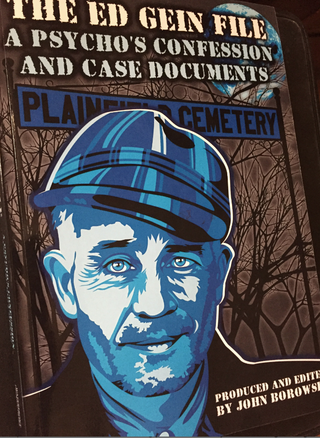Law and Crime
Secrets of Psycho
Documentary maker digs up grave robber Ed Gein’s confession and psych reports.
Posted June 23, 2016

This post contains graphic descriptions.
One of the first true crime books I ever read was about Ed Gein. I was so disturbed I gave it away so I wouldn’t have something like that in my house. (Yes, I’ve changed, considerably.) Now, when I teach my course on extreme offenders, I work my way up – or down – to Ed Gein, the killer who inspired Psycho, Bates Motel, Buffalo Bill and Leatherface. (I just saw an episode of Whitechapel based on Gein, too.)
Yet, for all the hype, he was just a whiny guy with "schizophrenic process" who loved his mother a bit too much and believed he could raise the dead. He blamed others for life’s difficulties (including an outside force that made him do things) and didn’t see what all the fuss was about when he was arrested for killing Bernice Worden.
But it wasn’t just murder. He beheaded and eviscerated her before hanging her body up like a deer. Her head was inside the house. Gein apparently thought she was a “bad” woman who deserved to die.
It was difficult to believe that this man who was "too squeamish" to hunt deer was in fact as ghoulish as the evidence indicated. During the search, police found chair seats made of human skin, a box of preserved female genitalia, a nipple-studded belt, a heart in a frying pan, a box of women’s noses, the sawed off crania from several skulls, death masks made from skin, a skin vest with breasts, a female scalp with black hair, and a pair of lips on a string.
Ewww.
But it wasn't all grim. He liked to ski and shoot arrows. He enjoyed square dancing and Westerns – at least, until after his mother died. And that’s what you’ll learn from John Borowski’s latest offering, The Ed Gein Files. You can read more about his work here (Albert Fish files) and here (serial killer culture). Borowski has a knack for finding items we all want to see but don’t know how to acquire.
He once told me: “My interest in serial killers is a combination of growing up watching horror films and my curiosity of morbid and macabre subjects, which can range from the stories of Edgar Allen Poe to the films of Alfred Hitchcock. In making films on serial killers, I hope to attempt to understand them and their actions. They are human beings just like all the rest of us and I feel it is society's responsibility to attempt to understand them and not just execute them so they are out of sight, out of mind.”
In his new book, he gives us crime photos, the full autopsy report on Bernice Worden, psychiatric reports from various professionals, a set of Gein's fingerprints, and period news accounts. The “main event” is Gein's lengthy confession. It’s packed with the mild-mannered rendering of strange stuff.
Gein admitted to stealing parts from freshly dead bodies in the cemetery. He had also killed Bernice Worden and another missing woman, Mary Hogan. He “knew” it was wrong, but he had plenty of moral deflections.
It’s interesting to see news reports from those days. People didn’t quite believe this story was real. We’re pretty jaded now, in the post-Dahmer age, with all of our Silence of the Lambs-type media, but this story was a shocker in 1957, coming out of an ordinary Wisconsin town. Who would think that their neighbor was digging up bodies, preserving human parts, and dressing himself in female skin suits? Why was there even a question whether he was insane?
Gein claimed that he'd dug up nine separate graves in three different cemeteries. (Officials did not believe him until they went out to exhume the dead. Some bodies weren't there. And that incident is in this book.)
Gein had supposedly hoped to transform into a woman, i.e., to become his mother. He had taken care of her after her strokes. In her room, he had created an apparent shrine to her.
Gein did have a trial, which is interesting for those who study mental health and the law, but was still found insane. Gein’s miserable goods were offered at an auction, and thousands showed up to bid. Entrepreneurs sought macabre souvenirs that they could display for a fee or sell to collectors.
There’s an interesting article in The Ed Gein Files about someone displaying his car, while other towns nearby turned up their moral noses at such a repugnant act. "That won't happen in Green Bay!"
The Gein legacy hangs over us. The popularity of Bates Motel, going into its fifth season, attests to that. And Borowksi’s collection of items in The Ed Gein Files is a terrific find. What you learn about this mentally ill man with no real healthcare resources is both amusing and sad.
He believed, for example, that it would have been better if he’d served in the military. He stated that if only his neighbor would have visited, none of this would have happened. He thought he would have married if he’d “found the right girl.” (Hey, Ed, try that nutcase who wants possession of Manson’s corpse.)
This is a unique view into the raw data of a disturbed mind. A friend of mine once performed Gein’s annual psychiatric review. He said, “He was a quiet little man.” So much can go on in seemingly quiet minds.
I can’t wait to see what Borowski digs up next. His books are welcome in my house.




